- Is Everest Base Camp Trek suitable for beginners?
- Preparing Your Body and Mind for the Everest Base Camp Trek
- Packing List for EBC Trek for Beginners
- Life on the Trail: What Can I Expect Each Day
- Safety, Health, and Altitude: What Beginners Must Know
- Cost, Permits, and Practical Logistics for Beginners
- Food, Water, and Accommodation for Beginners
- Accommodation during EBC Trek is in Teahouses
- Practical Tips for Beginners to Complete Everest Trip
- 5 main challenges for beginners on the Everest Base Camp
- The Verdict: Can Beginners Really Do the Everest Base Camp Trek?
- Everest base camp trek for beginners itinerary - 14/16 days trip package
- Frequently Asked Questions (FAQs)
- Conclusion
The idea of trekking to Everest Base Camp as a beginner can feel intimidating. This is especially true if you have never hiked before. Pictures of towering peaks, icy winds, and experienced climbers can make it seem impossible. But here's what most people don't know, the reality is completely different. The Everest Base Camp trek is challenging but totally achievable on well-established trails.
Every year, thousands of first-time trekkers with no prior experience reach the foot of the world's highest mountain safely. For those new to trekking, the words "Everest Base Camp" might bring scary images to mind.
You might picture cliffs, ropes, and climbers scaling icy walls. In reality, the trek is simply a long-distance walk, not a technical climb. For generations, these trails have carried Sherpas, yaks, and travelers from across the globe. This makes them accessible even to complete beginners.
The Everest Base Camp trek offers diverse terrain that remains very manageable. In the lower regions, you’ll pass through scenic forest trails and make your way across suspension bridges. Higher up, the trail winds over rocky moraines and gentle slopes. Most days involve five to seven hours of walking.
A beginner can trek to Everest Base Camp (EBC) with proper physical training, acclimatization, and preparation. While challenging, the trek doesn't require technical climbing skills, and its difficulty is manageable for first-timers who train adequately and take necessary precautions against altitude sickness.
You'll get regular breaks for food, tea, and just catching your breath. The trail is pretty well marked and winds through villages with these great little teahouses where you can warm up. Plus you're never really on your own, the local guides know these mountains like the back of their hand and they're always there when you need a boost.
Now here's what nobody tells you upfront, it's not the walking that's going to kick your butt, it's the thin air. Once you get up to Base Camp at around 17,600 feet, just walking to the bathroom feels like you ran a marathon. That's why any decent trek schedule builds in rest days at places like Namche Bazaar and Dingboche. You're basically letting your body catch up to where you are. Trust me, those extra days aren't luxury, they're what keep you from getting seriously sick up there.
Your guides monitor trekkers daily, too. They remind everyone to stay hydrated, eat well, and maintain a steady pace. Another widespread misconception is that only elite athletes can complete this trek. This is simply not accurate. The majority of successful trekkers are regular individuals who prepare through consistent walking, stair climbing, and moderate cardiovascular exercise in the months leading up to their departure.
On the trail, the local mantra is "slowly, slowly," or bistari, bistari in Nepali. Making it to the top isn't really about being the strongest person out there, it's more about just keeping at it and not rushing yourself. You literally put one foot in front of the other and keep going.
So, if you're worried about being a complete novice, don't be. The Everest Base Camp trek for beginners is designed for everyday people, not just elite climbers. With expert guidance, you’ll have an unforgettable experience. The journey isn’t just about reaching the peaks; it’s about discovering your own strength and resilience along the way.
Is Everest Base Camp Trek suitable for beginners?
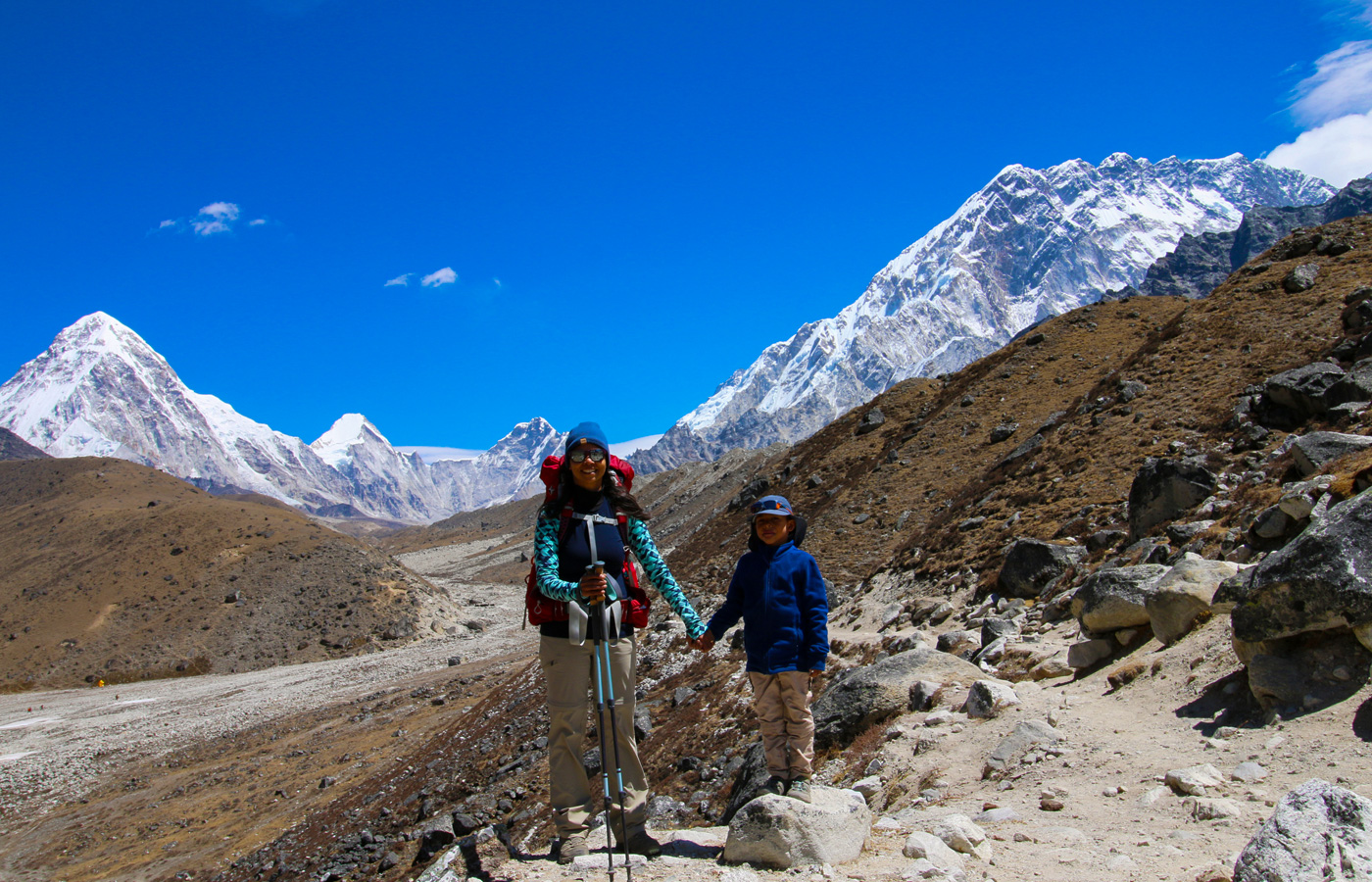
Yes, the Everest Base Camp (EBC) trek is generally suitable for beginners if they are well-prepared, focusing on proper physical training, gradual acclimatization, and having the right gear. While not an easy task, it's achievable for those who can handle moderate physical exertion and understand the challenges of high altitude, which is the primary difficulty rather than technical climbing skills or immense distance.
Key Considerations for Beginners:
Preparing Your Body and Mind for the Everest Base Camp Trek
Physical preparation is what separates a smooth, enjoyable trek from a tiring one. The good news is that you don’t need to be an athlete to succeed on the Everest Base Camp trek as a beginner.
Every year, many first-time trekkers with no experience, including those trekking without a guide, complete the journey safely. The key is to build stamina gradually, strengthen your legs, and get used to walking for several hours at a time. It’s less about speed and more about pacing yourself steadily.
Mount Everest Base Camp Trek for Beginners: A journey of lifetime
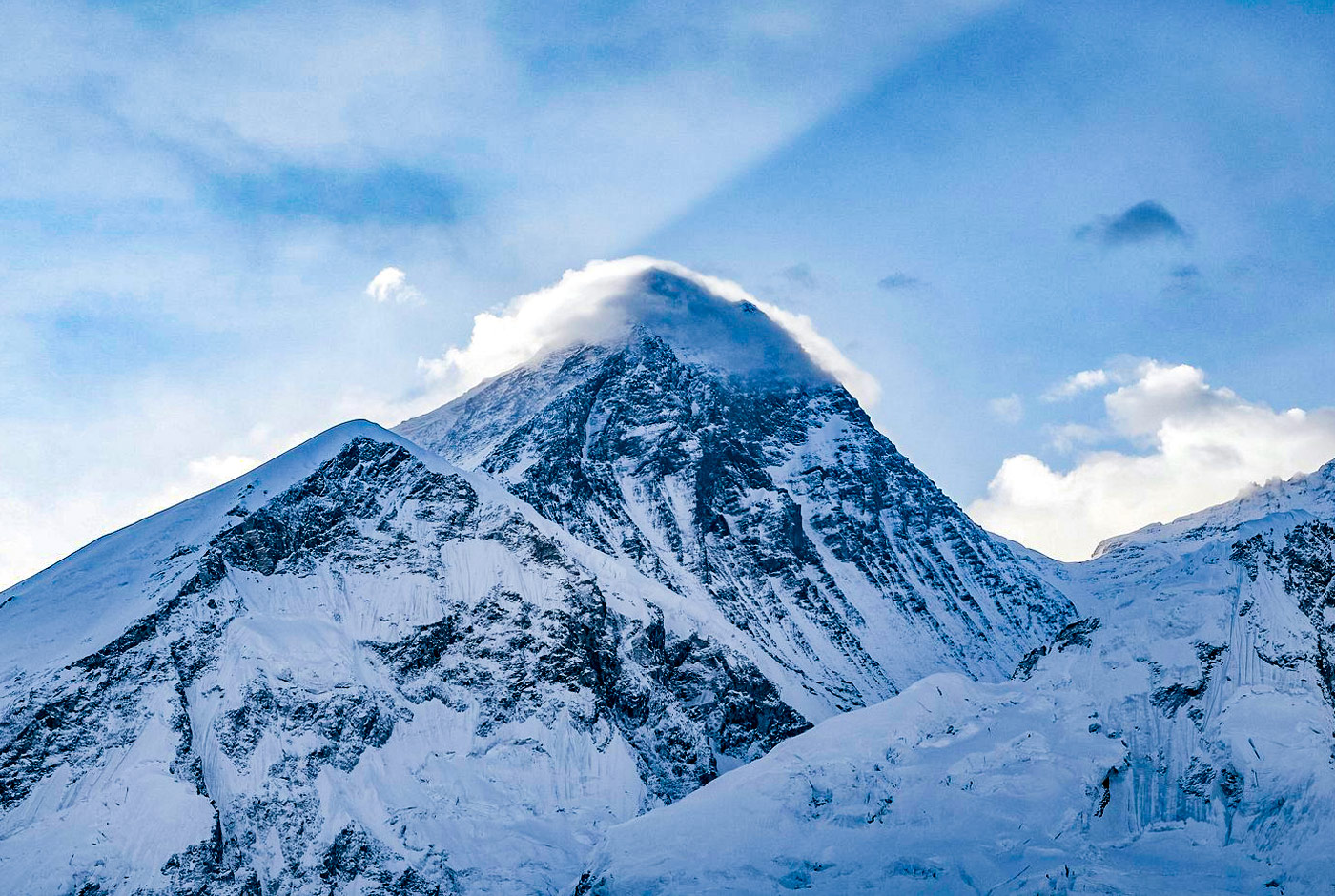
Building Fitness Gradually
For novice trekkers and complete beginners, it’s best to start preparing at least two to three months before the trek. Walking forms the foundation of your training. Begin with 30 to 40 minutes of walking, four to five times a week, and gradually increase your sessions to three or four hours.
If you live in a flat area, stairs, stadiums, or treadmills with incline are excellent substitutes, with stair climbing especially helpful in simulating uphill trails.
When you feel good about your walking, throw a small backpack on and slowly add more weight. Start with about 11 pounds, then work up to 18 or 22 pounds. This gets you used to the daypack you'll actually be carrying. Try doing one long walk each weekend maybe 5 or 6 hours with some rest stops. Those long walks do wonders for your stamina and help you figure out how to keep a steady pace when you're actually out there for real.
Strength and Core Training
Is Mount Everest Base Camp trek suitable for beginners?
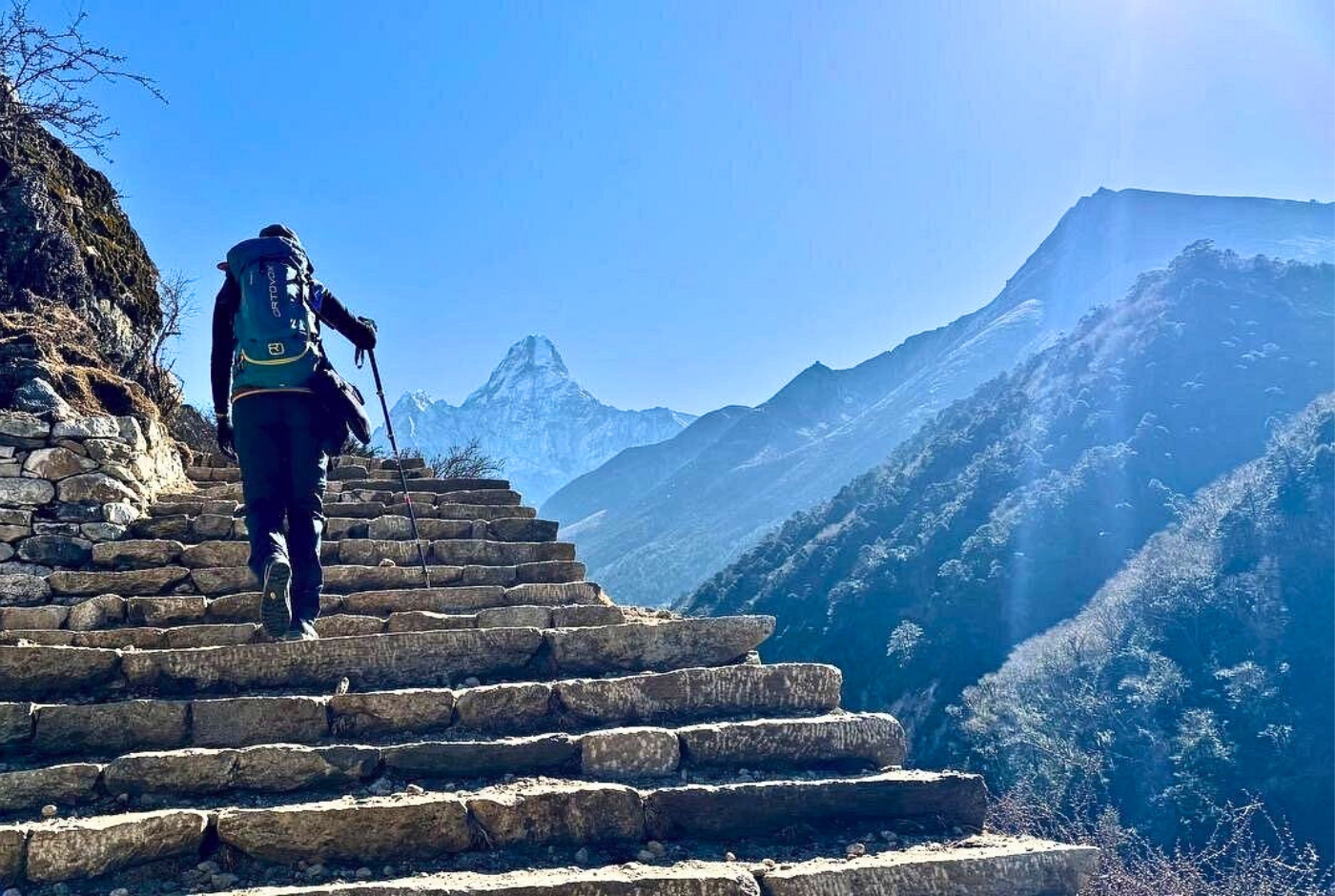
For beginners preparing for the Everest Base Camp (EBC) trek in Nepal, a training plan focused on building cardiovascular endurance, lower-body strength, and mental resilience is essential. Begin your preparation at least 8 to 12 weeks before your trip, prioritizing consistent, moderate-intensity training over a few months.
Strength training helps you prevent injuries and build confidence for long hikes. Focus on exercises that target the muscles most used on the trek. A simple routine could include:
- Squats, lunges, planks, and step-ups to strengthen your legs and core
- Swimming, cycling, or light jogging for cross-training and your endurance
- Two to three short sessions each week
- These exercises are beneficial for first-time trekkers with no experience, giving both strength and confidence for the trail.
Check the detail blog about: How to train for Everest Base Camp Trek Guide here
Mental Preparation
Can a beginner do Everest Base Camp Trek without Guide and porter?
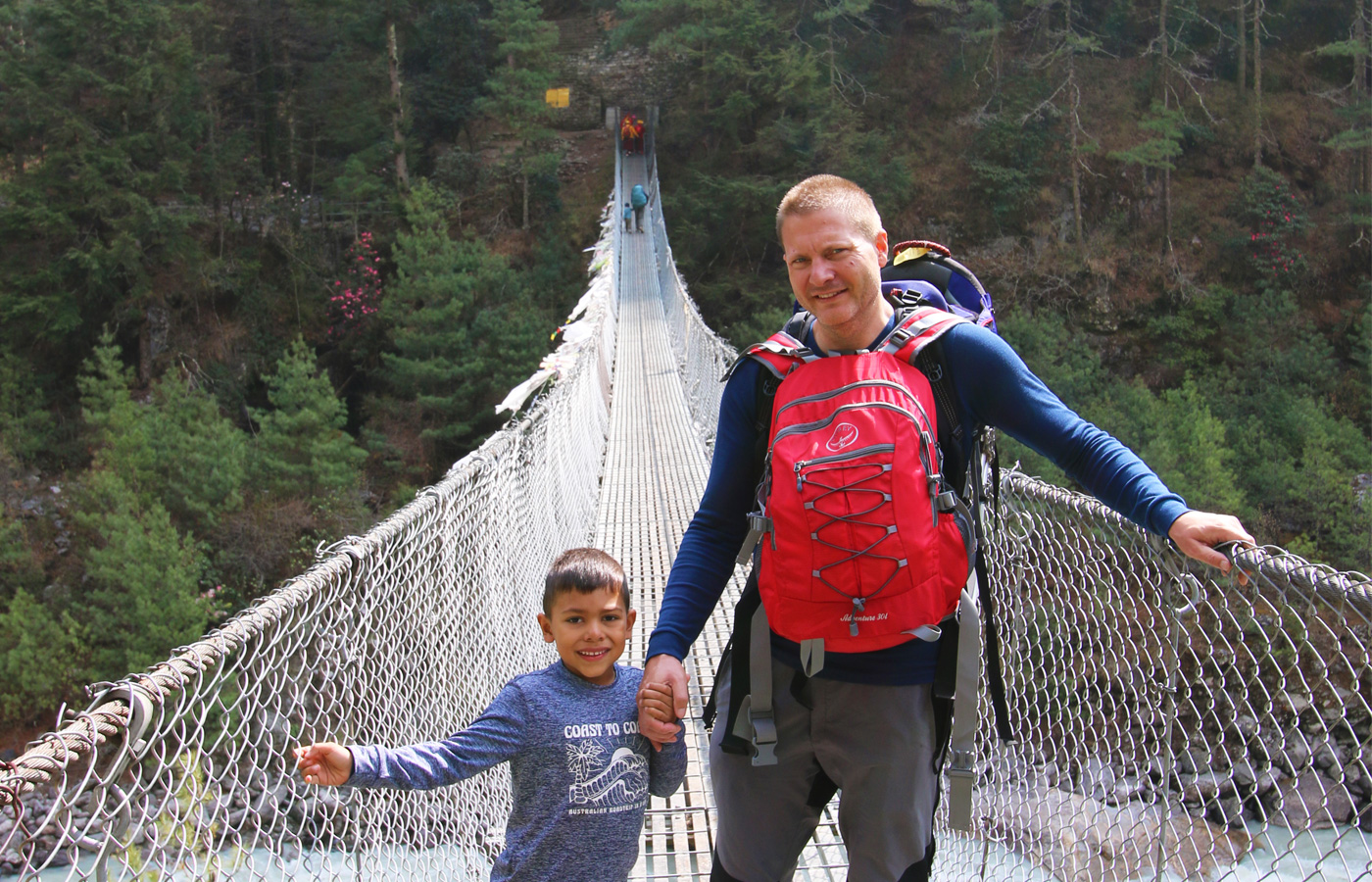
The Everest Base Camp trek tests both your body and your mind. For many novice trekkers, early mornings, basic teahouses, and times when altitude makes you feel drained are the toughest moments. Keeping realistic expectations and accepting some discomfort as part of the adventure makes the trek easier and more enjoyable.
Doing some yoga, meditation, or just practicing breathing techniques can really help you stay calm and focused when things get tough up there. Even if you're going solo on your first trek, you'll quickly realize that getting your head right is every bit as important as getting your legs ready.
Acclimatization Matters
Altitude is the biggest challenge for beginner trekkers to Everest Base Camp. No amount of sea-level training can fully prepare the body for thin air above 3,500 meters. That’s why well-planned Everest Base Camp itineraries for beginners include acclimatization days (mostly in Namche Bazaar and Dingboche), where you hike to higher elevations during the day and return to sleep lower.
Benefits of acclimatisation:
- Helps your body adjust safely to high altitude
- Reduces the risk of altitude sickness
- Allows even novice trekkers to continue comfortably
With consistent preparation over three months and careful pacing, anyone, even first-time trekkers with no experience, can arrive in Nepal ready for the adventure. Training is not a chore; it’s the first step toward waking beneath Himalayan dawns. Walking through stunning landscapes and standing at the foot of the world’s highest peaks.
Choosing the Perfect Time
The best time for beginners to trek to Everest Base Camp is during the pre-monsoon (spring), from March to May, and the post-monsoon (autumn), from September to November, due to stable weather, clear skies, and manageable temperatures. These seasons offer the best conditions with less risk of weather disruptions, clear mountain views, and breathtaking landscapes, making them ideal for first-time trekkers. However, Everest Base Camp Trek can be done during Summer and winter as well.
Best Time for Mount Everest Base Camp Trekking for first time trekkers
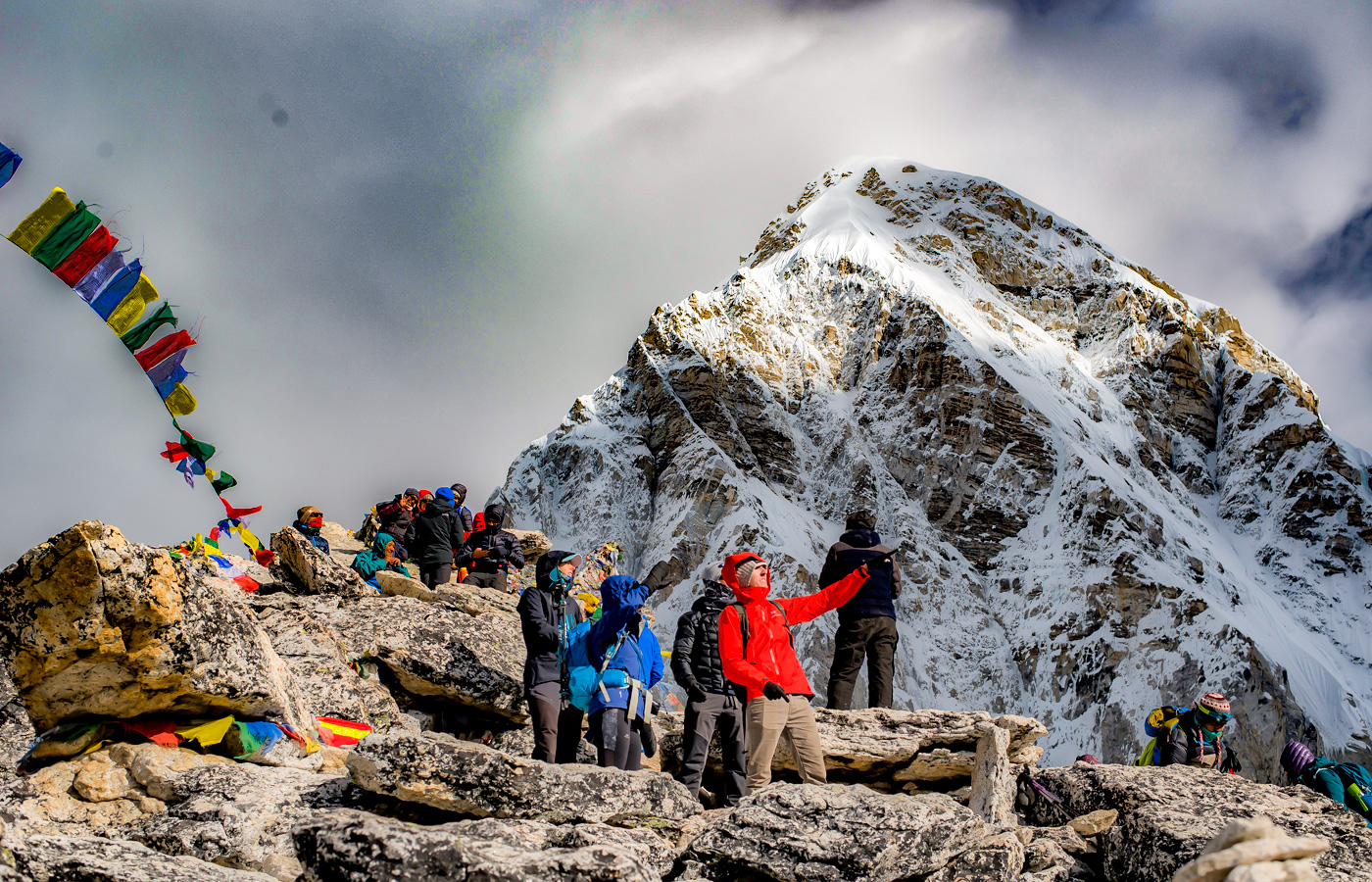
Spring (March–May)
- Clear skies and blooming flowers: The trails are vibrant with rhododendrons and other alpine flowers, creating beautiful scenery.
- Moderate temperatures: Daytime temperatures are comfortable, though it can still get cold at night.
- Good visibility: Clear weather provides excellent views of Everest and surrounding peaks.
Autumn (September–November)
- Stable and clear weather: This season is known for crisp, clear weather and stable conditions, ideal for high-altitude trekking.
- Mild temperatures: Daytime temperatures are mild, though often cooler than in spring.
- Cultural experiences: The autumn season aligns with Nepal's biggest festivals, offering opportunities to experience local traditions.
Packing List for EBC Trek for Beginners
For many beginner trekkers, getting ready for the Everest Base Camp trek can feel overwhelming. What should you bring? What can you skip? The key is to pack only the essentials, use layers for your clothing, and know that bulky gear can be rented in Kathmandu. Traveling light but wisely makes the trek much easier and more enjoyable.
What should you carry in your backpack for the Everest Base Camp Trek as Beginner?
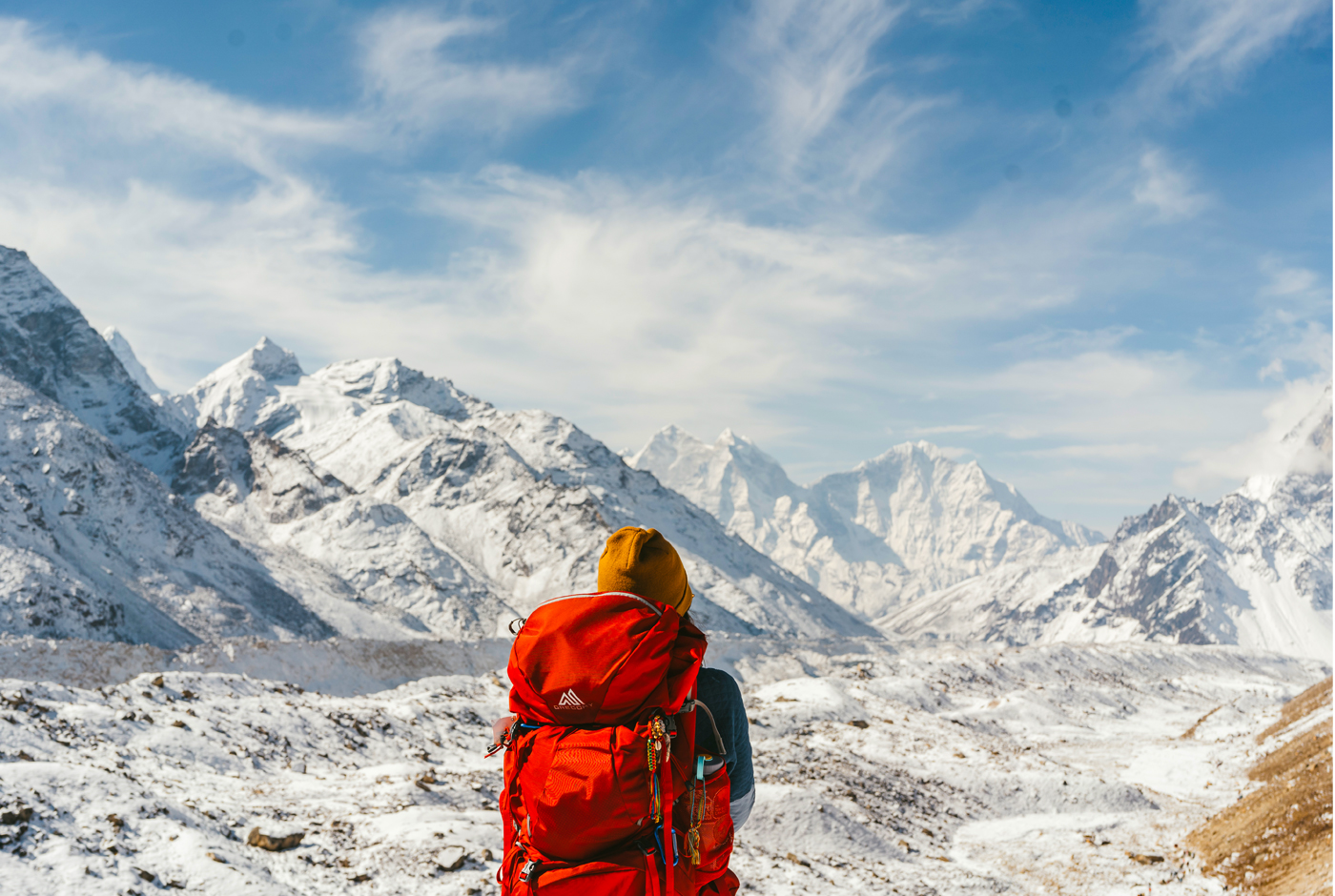
The Layering System
In the Himalayas, the weather changes quickly. Instead of carrying one heavy jacket, a layering system works best for you. Three light layers keep you warm, dry, and flexible throughout the trek:
- Base Layer: Thermal tops and bottoms made from synthetic fabrics or merino wool. These help wick sweat and keep you dry.
- Mid Layer: A fleece or lightweight down jacket to provide insulation.
- Outer Layer: A waterproof, windproof shell jacket and trousers for rain, snow, or strong winds.
This system is handy for beginners and novice trekkers because it keeps you comfortable during warm afternoons and freezing nights without weighing you down.
Footwear: Your Most Important Investment
If there’s one item you shouldn’t compromise on, it’s your boots. Waterproof trekking boots with strong ankle support are essential. Buy them early and break them in with weeks of walking before the trek.
Wear them with good merino wool or synthetic socks, and your feet will thank you when you're not dealing with blisters. If this is your first time doing something like this, don't cheap out on boots. Good ones can totally make or break your whole trip.
Sleeping Bag and Warmth
Tea houses along the route provide blankets, but they’re not warm enough once you reach higher altitudes. A sleeping bag rated to around 15°F (-5°C) is a must.
Many beginners rent one in Kathmandu to save space in their luggage. A warm down jacket, also available for rent, is another lifesaver for chilly evenings.
Daypack vs. Duffel Bag
Here's a natural, human version keeping the same format:
Your stuff basically gets split into two bags:
- A duffel bag (up to 44 pounds) that a porter carries for you.
- A daypack (25–30 L), packed with the daily essentials: water, snacks, sunscreen, rain jacket, and your camera.
Don't overload that daypack. Everything feels like it weighs twice as much once you get up high, so even that extra energy bar starts feeling like a rock.
Other Essentials for the Trek
Along with clothing and footwear, a few key items can make life on the trail much smoother:
- Trekking poles can reduce stress on your knees.
- Water purification tablets or a filter bottle for safe drinking water.
- A headlamp for early morning starts and teahouse power cuts.
- A power bank or solar charger, as charging electronics can be costly.
- A small first-aid kit with blister plasters, pain relief, personal medicines, and Diamox (if recommended by your doctor).
- Hygiene basics like wet wipes, sanitizer, a quick-dry towel, and toilet paper.
- Accessories include sunglasses, gloves, a buff, lip balm with SPF, and a sun hat.
Renting vs. Buying
One advantage of trekking in Nepal is the wide availability of rental gear in Kathmandu Valley. You can rent down jackets, sleeping bags, and trekking poles in Thamel for pretty decent prices.
However, some items should always be bought new and brought from home:
- Trekking boots (to break them in early)
- Socks, base layers, and underwear
- Personal medicines
Always double-check rented items for warmth, quality, and comfort before starting the trek.
Packing Tips for Beginners
Packing for Everest Base Camp is all about keeping it smart, don't try to bring your entire closet. A few tips make it easier:
- Use small stuff sacks or zip bags to keep clean and used clothes separate.
- Keep a “teahouse set” of warm, clean clothes to change into after walking each day.
- Stick to a light, layered style of packing; it keeps you flexible without extra weight.
Many novice trekkers make the mistake of overpacking, but the absolute comfort comes from carrying less. A smart, streamlined packing list helps first-time trekkers feel prepared, light, and ready for the adventure of standing at the base of the world’s highest mountain.
For a beginner's Everest Base Camp (EBC) trek, pack essential clothing with a layering system. Find the detailed manual of the EBC Trek packing list on this site: What to pack for Everest Trek?
Life on the Trail: What Can I Expect Each Day
For many novice trekkers, the biggest worry before embarking on the Everest Base Camp trek is not knowing what daily life will be like. Will it be endless uphill climbs? Will the lodges be too basic? The truth is, the trek has a simple rhythm: walk, eat, rest, and repeat.
Once you fall into this pattern, the days stop feeling overwhelming and start becoming deeply rewarding. Many beginners say it’s the steady routine, regular mealtimes, fixed walking hours, and evenings in cozy dining halls that make the Everest Base Camp trek for beginners so achievable.
A Typical Day on the Trail
Life starts early in the mountains. Around 6:30 or 7:00 AM, you’ll wake to the thin air of the Himalayas. Breakfast is served, which includes porridge, eggs, pancakes, or Tibetan bread with honey. By 8:00 AM, most trekkers are on the trail, carrying only a small daypack while a porter moves the heavier duffel bag ahead.
The morning usually involves two to three hours of walking, with breaks for tea, photos, or to let yaks and porters pass. Around midday, you’ll stop at a teahouse for a hot lunch, featuring options such as fried rice, noodles, or the famous dal bhat (a combination of rice, lentils, and vegetables).
The afternoon brings another stretch of steady walking, averaging two to three hours. By mid-afternoon, you’ll arrive at the next village, check into a teahouse, and rest. Some people nap, while others read, write in a journal, or wander around the town.
Dinner is served around 6:00 or 7:00 PM in the dining hall, where a stove fueled by yak dung is often the only source of heat. After a warm meal and plenty of chatter, most trekkers head to bed by 9:00 PM. Early nights quickly become part of the routine, even for first-time trekkers with no experience.
The Teahouse Experience
Can a normal person go to Everest Base Camp?
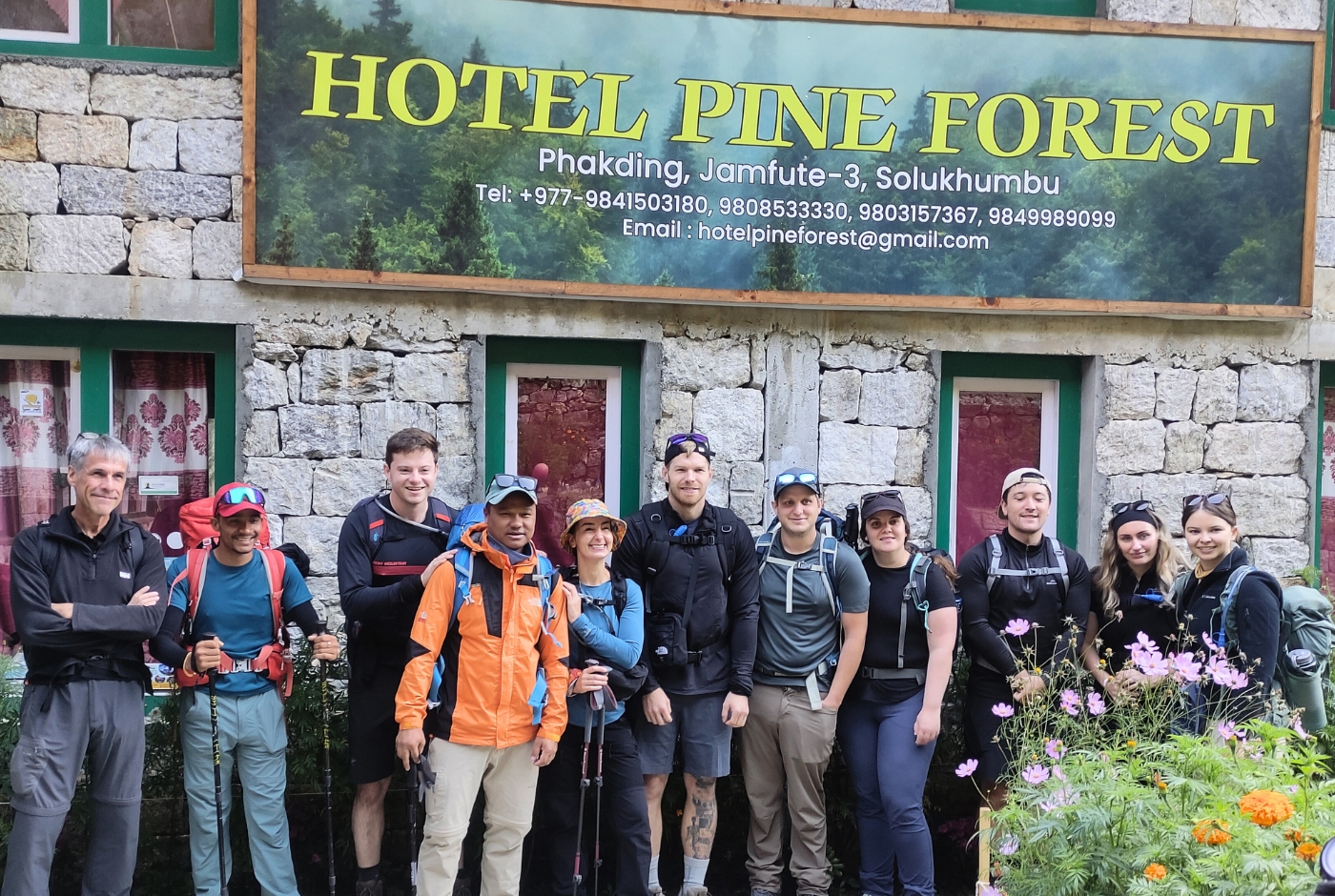
Teahouses are welcoming but straightforward. Run by Sherpa families, they provide basic rooms with two single beds, a mattress, a pillow, and a blanket. At lower altitudes, some rooms have attached bathrooms, but at higher altitudes, toilets are often shared and are typically squat-style.
Hot showers may be available for an extra fee, but many beginners skip them above 4,000 meters, relying instead on wet wipes. The dining hall is the heart of the teahouse where trekkers gather each evening to warm up, play cards, swap stories, or simply enjoy the company of others.
Electricity and Wi-Fi are available in some lodges, but both come at a cost, and charging devices get pricier as you climb higher. While the rooms are basic and often cold, the atmosphere in the dining hall is what most families and beginners remember long after the trek.
Food and Water on the Trek
Menus are surprisingly varied. You’ll find pancakes, soups, fried rice, pasta, and plenty of snacks. Still, the most popular dish is dal bhat, which is nutritious, filling, and often served with free refills. Guides usually suggest beginners stick to vegetarian meals since meat is carried up without refrigeration and can cause stomach problems.
When it comes to water, there are several options. You can buy boiled water at teahouses, use purification tablets, or carry a filter bottle. Bottled water is available, but it becomes expensive for you at higher elevation, and it contributes to plastic waste. For first-time trekkers, purification tablets are the easiest and most affordable way to stay safe and hydrated.
The Walking Experience
Most days involve walking at a slow pace. On special days, like reaching Everest Base Camp itself or climbing Kala Patthar, it can stretch to eight or nine hours. The pace is steady, not rushed, and full of breaks. This approach enables novice trekkers, even those without prior guide experience, to acclimate to the altitude while enjoying the scenery.
The Mental Side of the Trek
The Everest Base Camp trek tests your mind as much as your body. The internet is limited, rooms are cold, and toilets can be basic. Fatigue builds after days of walking. However, many beginners and families report that the simplicity of life, just walking, eating, and resting, soon becomes calming. Without the usual distractions, you focus only on the present step, the next meal, or the conversations with fellow trekkers.
For first-time trekkers with no experience, this mental shift is often the most surprising part of the journey. The hardships, such as thin air, smoky dining rooms, and chilly nights, are real. However, so are the rewards such as patience, resilience, and the joy of reaching the foot of the world’s highest mountain.
Safety, Health, and Altitude: What Beginners Must Know
Can a beginner do EBC Trek?
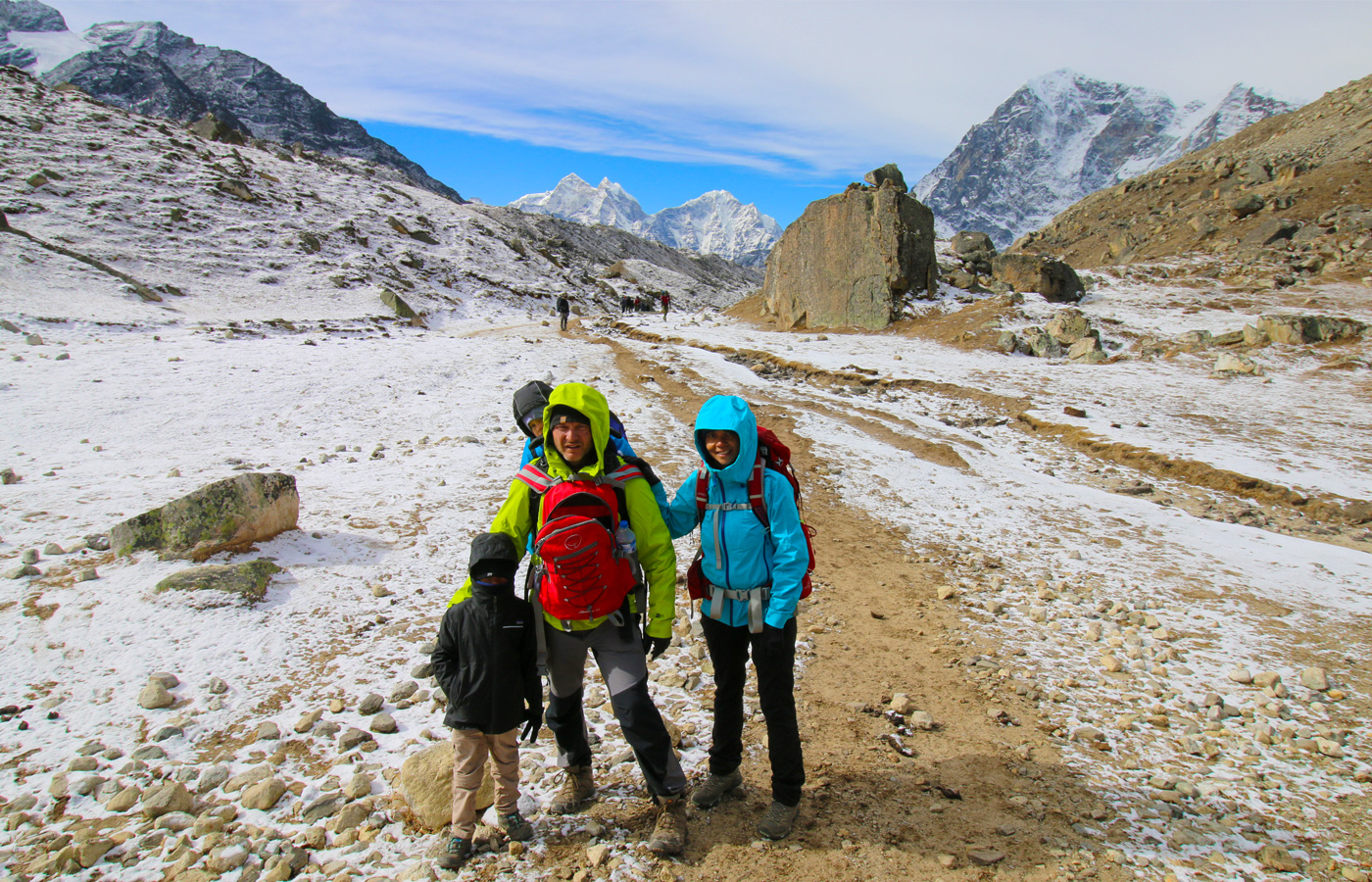
If you've never done a big trek before, here's the thing, it's not really about how far you walk or how tough the path is. It's the altitude that'll get you. The higher you go up into the Khumbu, the thinner the air gets, and your body has to work way harder just to breathe. When you finally make it to Base Camp, that's at about 17,600 feet, there's literally half the oxygen you're used to down at sea level. That's why even tying your shoes can leave you winded up there.
Look, if this is your first rodeo, or you're bringing the family, or you've just never done anything like this before, learning about altitude sickness is every bit as important as figuring out what boots to bring. Don't mess around with it.
What Altitude Sickness Means
Altitude sickness, also known as Acute Mountain Sickness (AMS), happens when your body struggles to adapt to lower oxygen levels. It can affect anyone, whether you are young, old, fit, unfit, a beginner, or an experienced trekker. Fitness has little to do with it. What really matters is how quickly you ascend and how much time you give your body to rest.
The common signs to watch for include:
- A headache is often the first symptom
- Nausea or loss of appetite
- Dizziness or light-headedness
- Fatigue or shortness of breath
- Trouble sleeping
Red flag symptoms include loss of coordination or breathlessness even while resting. If ignored, AMS can develop into life-threatening conditions like High-Altitude Pulmonary Edema (HAPE) or High-Altitude Cerebral Edema (HACE). The only real treatment for severe cases is to descend immediately.
How to Prevent Altitude Problems
The good news is that most cases can be prevented if you follow a few golden rules:
- Ascend slowly: After reaching 3,000 meters, avoid sleeping more than 500 meters higher than the previous night. Rest days at Namche Bazaar (3,440 m) and Dingboche (4,410 m) are built into beginner-friendly itineraries for this reason.
- Climb high, sleep low: On rest days, take short hikes to higher viewpoints, then return to sleep at a lower level.
- Stay hydrated and eat well: Drink at least three liters of water daily and fuel up with plenty of carbs.
- Avoid alcohol and smoking: These reduce oxygen efficiency and slow your body’s adjustment.
- Speak up if you feel unwell: For beginners and first-time trekkers without guide support, it’s easy to ignore symptoms. But catching them early makes all the difference.
Medical Support on the Trail
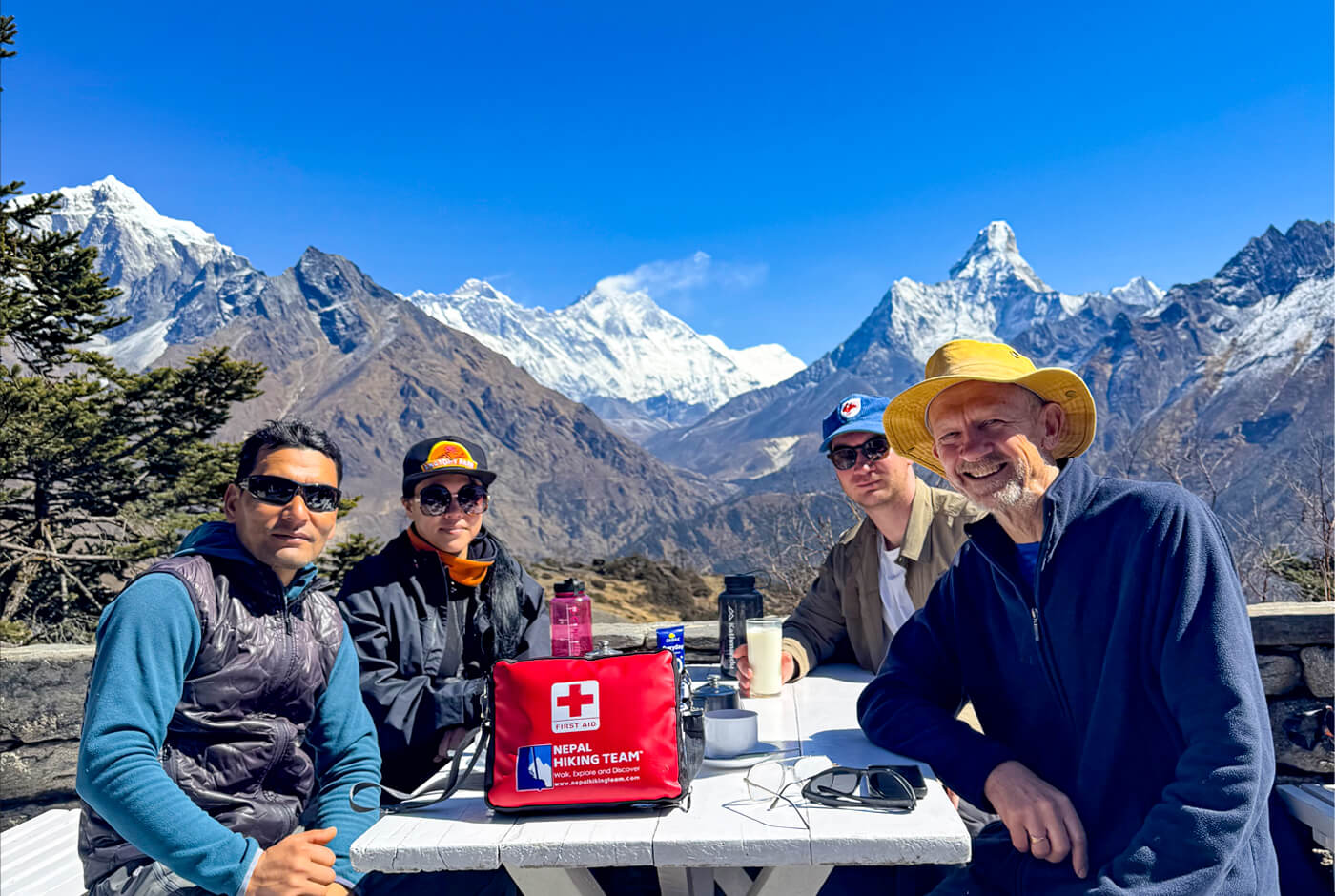
Before leaving home, talk to your doctor about Diamox (Acetazolamide). This medicine can help your body adjust more quickly, but it’s not a cure. Even if you take it, rest and acclimatization are still essential. Carry a small first-aid kit with painkillers, blister plasters, and any personal prescriptions.
Guides in the Everest region are trained to spot altitude sickness and may use a pulse oximeter to check oxygen levels. But what really matters are your symptoms. If they get worse, the only safe option is to descend.
Medical help is available in the Khumbu. The Himalayan Rescue Association (HRA) runs an aid post at Pheriche (4,371 m), and Everest ER provides emergency care at Base Camp during peak trekking season. Both clinics can give oxygen and arrange helicopter evacuation if needed.
Why Insurance is Non-Negotiable
Every beginner must have travel insurance that covers high-altitude trekking and helicopter evacuation. A standard travel policy won’t be enough. Look for coverage up to at least 6,000 meters. Some companies also require pre-approval before evacuation, so always check the details. This insurance serves as your safety net in the event of an unexpected issue.
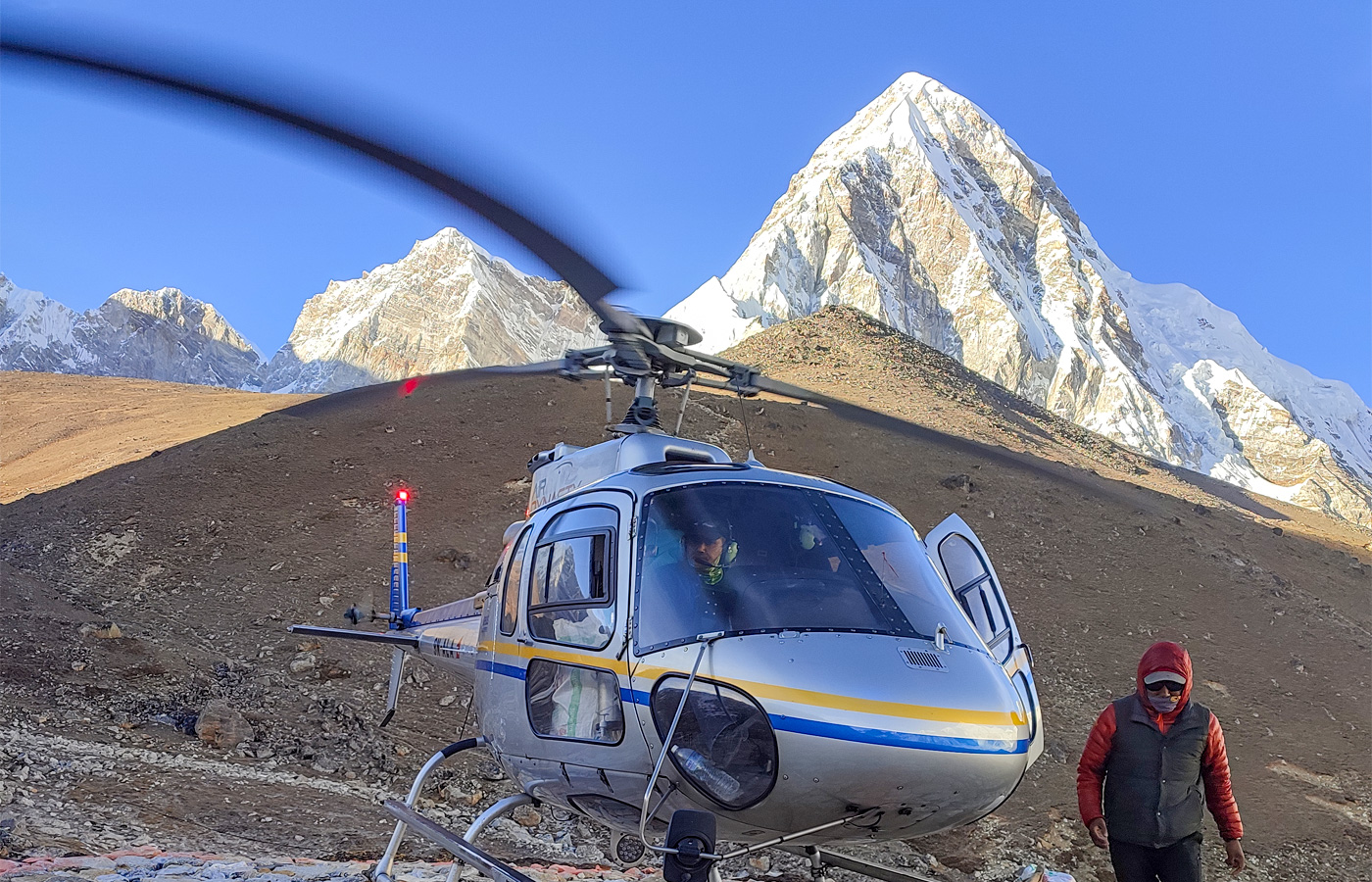
Other Safety Tips for Beginners
- Permits: You’ll need the Sagarmatha National Park entry and the Khumbu Pasang Lhamu Rural Municipality permit. These are checked on the trail.
- Solo trekking: Since 2023, most areas in Nepal require a licensed guide. The Everest region still allows solo trekking, but for beginners and families, hiring a guide is strongly advised for safety.
- Trail safety: The paths are uneven and shared with yaks and mules. Always step to the mountainside, not the edge. Trekking poles help with balance.
- Suspension bridges: These long bridges are safe, but they sway. Cross slowly and steadily.
- Food safety: Meat is flown into Lukla and carried up without refrigeration. Above Namche, stick to vegetarian meals like dal bhat, eggs, potatoes, or soups.
- Weather: Even in the best seasons, weather can change fast. Snow, high winds, and freezing nights are common. Spring (March–May) and autumn (late September–November) are the safest times for trekking.
- Hygiene: Wash your hands as needed or use hand sanitizer to prevent stomach problems.
- Charging and Wi-Fi: Available at most teahouses, but at an additional cost. The higher you go, the more it costs.
Trekking is for All Ages
Best Beginner Everest Base Camp Trek
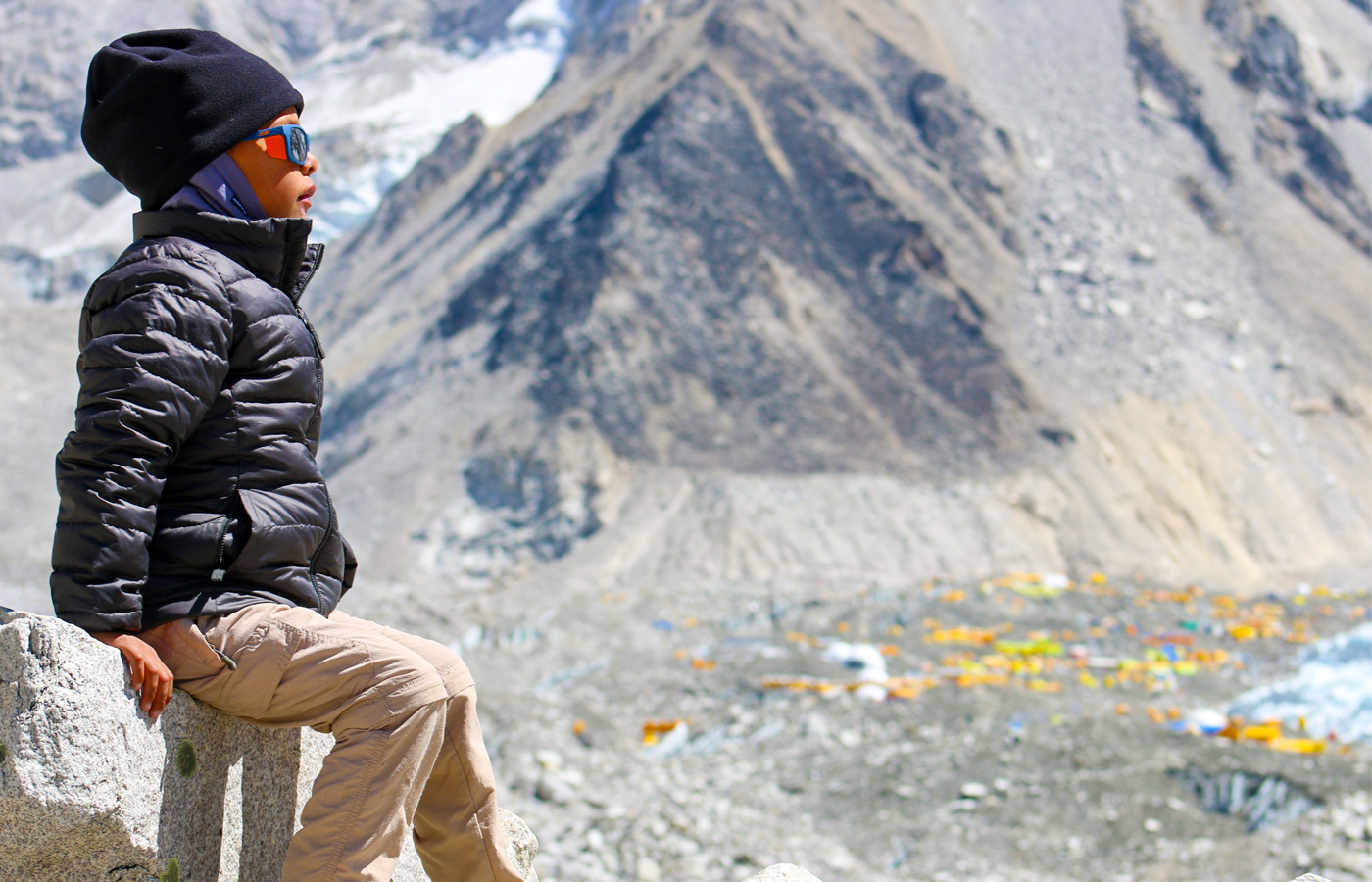
One of the best things we’ve seen on the trail is the diversity of trekkers. We’ve guided families with kids as young as five, as well as seniors in their late seventies. Age doesn’t stop people from reaching Base Camp; it’s about patience, preparation, and the proper support. Many of them tell us how happy they are with the care and service they received.
Cost, Permits, and Practical Logistics for Beginners
Planning the Everest Base Camp trek as a beginner often feels overwhelming. Questions like “How much will it cost?”, “What permits do I need?” and “What should I expect on the trail?” are common questions, especially for novice trekkers or families with no prior experience.
Let’s break it down step by step so you can prepare with confidence.
The Cost of an Everest Base Camp Trek
The overall cost for the Mount Everest trek depends on whether you trek with a local company, choose a group package, or prefer a more private experience. On average, a guided trek costs between USD $1,200 to $2,400 per person for a 12–14 day itinerary. This usually includes:
- Trekking permits
- Round-trip flights between Kathmandu (or Ramechhap) and Lukla
- Accommodation in teahouses during the trek
- Three daily meals on the trail
- Licensed guide and porter support
What’s not included are international flights, personal gear, snacks, Wi-Fi, charging fees, insurance, and tips. Beginners should set aside an extra $500–$1,000 for these additional costs.
So, if you’re a first-time trekker, expect a realistic budget of $2,000–$3,500 for the whole trip, including insurance and gear.
Daily Trail Expenses
Throughout the trek you’ll spend money on extras such as:
- Hot showers: You’ll have to pay $3–$5, with prices higher at higher elevations
- Device charging: $2–$5 per hour
- Wi-Fi or internet cards: $5–$10 per session
- Snacks and drinks: chocolate, tea, and soda get pricier the higher you climb
Cash is essential. ATMs are available in Lukla and Namche Bazaar, but are often unreliable. Beginners should withdraw enough Nepalese Rupees in Kathmandu before flying to Lukla.
Permits You’ll Need
Two permits are required for the Everest Base Camp trek:
- Sagarmatha National Park Entry Permit – NPR 3,000 (around $25 USD)
- Khumbu Pasang Lhamu Rural Municipality Permit – NPR 2,000 (around $15 USD)
If you trek with a local company, they will handle this paperwork for you. For beginners, this is the easiest option to avoid stress or mistakes.
Detailed coverage of the Everest Base Camp Trek permit with cost here.
The Lukla Flight
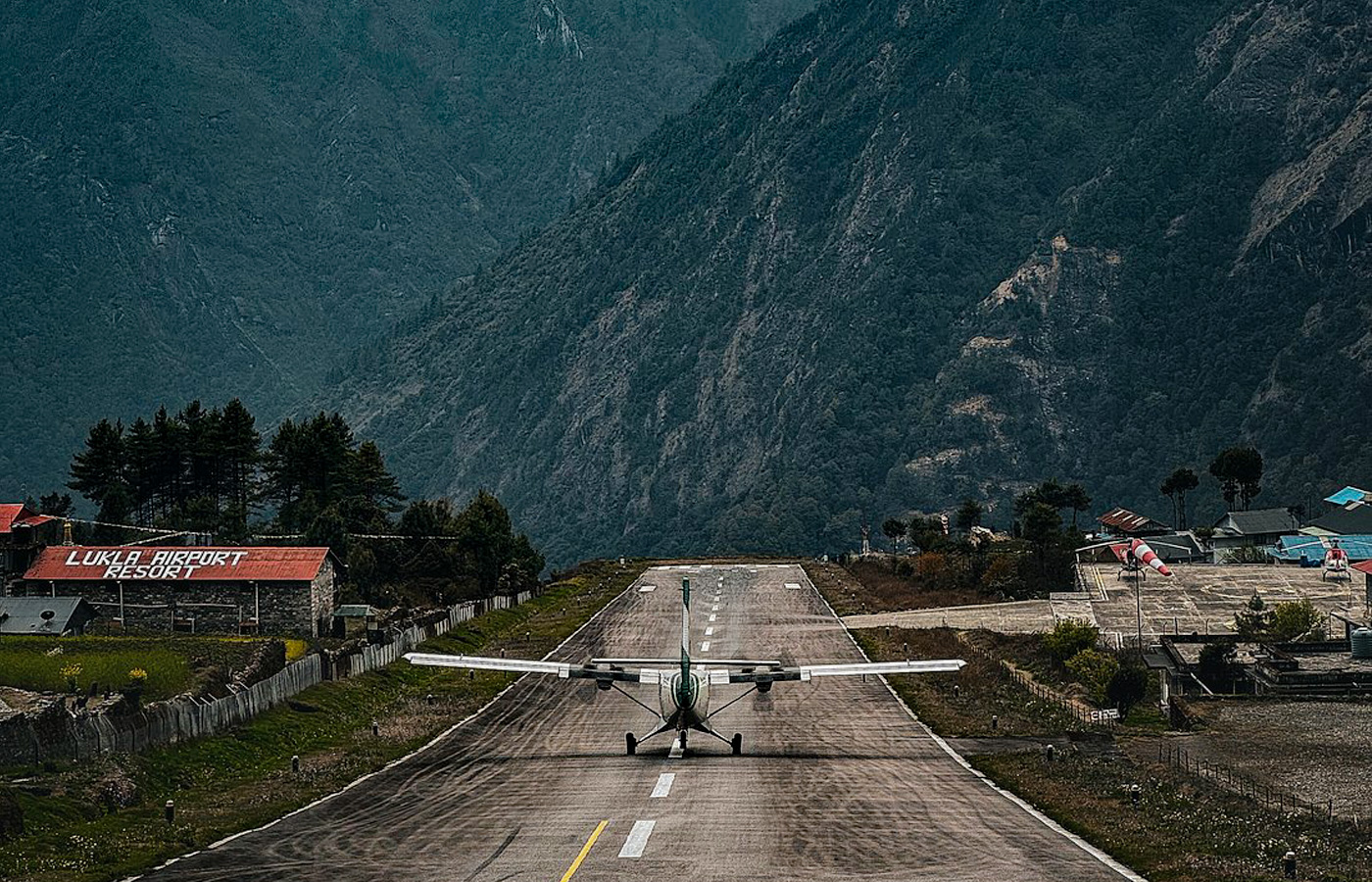
Most treks begin with a short, scenic flight to Lukla, the famous gateway to the Khumbu region. During busy trekking seasons, flights are often diverted to Ramechhap/Manthali Airport (approximately a 4–5 hour drive from Kathmandu) due to increased air traffic.
This part of the journey can test your patience, as weather delays are common. For novice trekkers or families with no experience, flexibility is key. Your adventure begins the moment you step onto that small mountain plane.
Guided Support Is Now Compulsory
Can I do Everest Base Camp Trek without a Guide as a beginner?
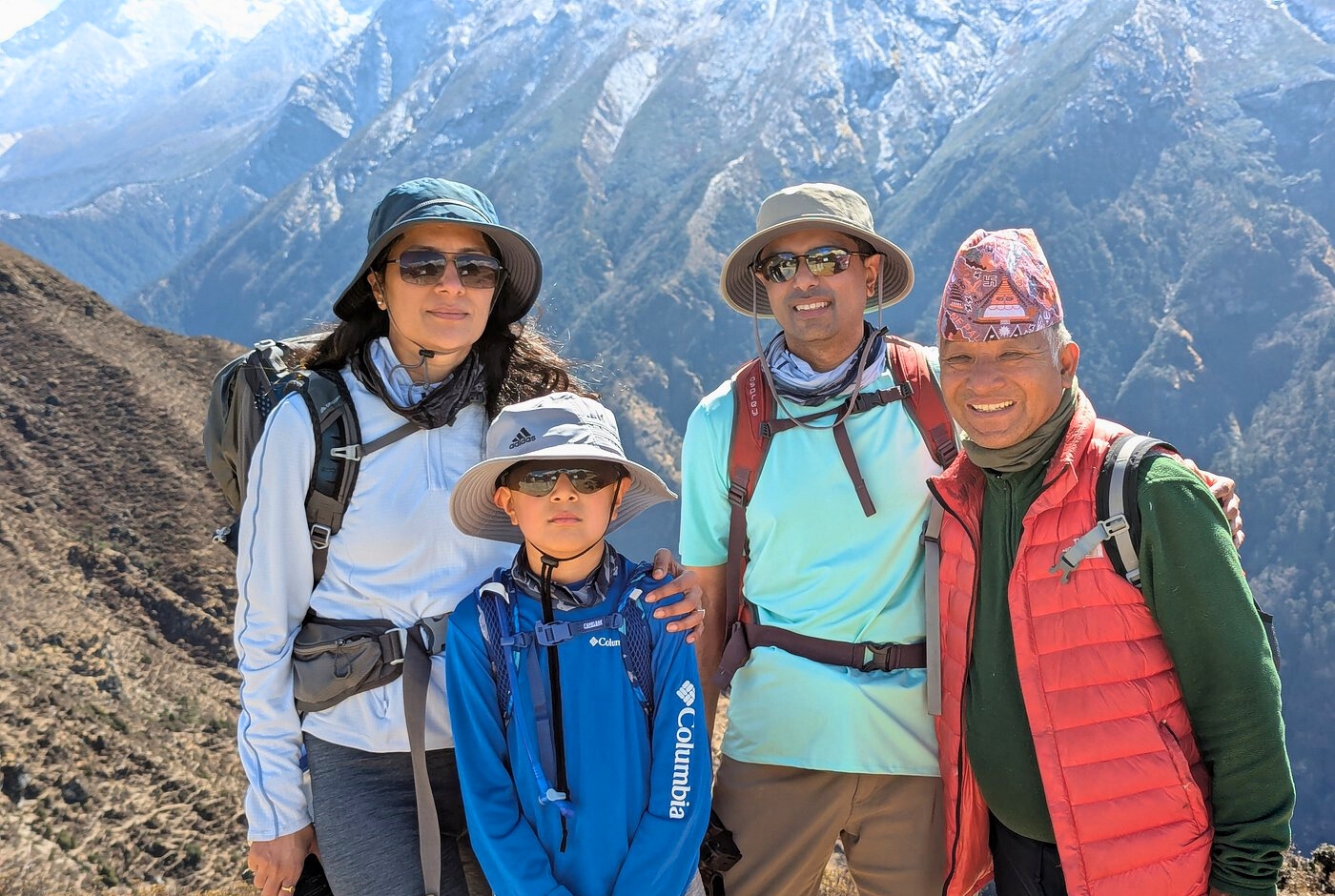
Since 2023, most trekking routes in Nepal, including the Everest Base Camp route don’t allow solo trekking. Hiring a licensed guide is mandatory.
This rule is actually a blessing for first-time trekkers. Guides ensure your safety, monitor altitude health, handle logistics, and offer cultural insights that enrich the experience. For families or beginners without guide support, the trek would feel overwhelming so this change makes the journey much smoother.
Travel Insurance and Visas
- Visa: Most travelers can get a visa on arrival in Kathmandu. A 30-day visa costs $50 USD.
- Insurance: Make sure your policy covers trekking up to 6,000 meters and helicopter evacuation. Regular policies don’t cover this, but it’s non-negotiable for the Everest region.
Food, Water, and Accommodation for Beginners
One of the biggest worries for novice trekkers is, “Where will I sleep and what will I eat?” The good news is that the Everest Base Camp trek has one of the best lodge systems in the world.
What You’ll Eat on the Trail
Meals on the Everest Base Camp trek consist primarily of Nepali staples like dal bhat (rice and lentil soup), momos (dumplings), and various noodle dishes, alongside international options such as pizza, pasta, and breakfast items like porridge, eggs, and pancakes. You'll also find snacks like dried fruits and nuts, and hot drinks such as tea, coffee, and butter tea to provide energy and warmth at altitude.
Menus are more varied than many beginners expect. Teahouses offer both Nepali staples and familiar international dishes. You’ll find:

- Dal Bhat (rice, lentil soup, vegetable curry), the ultimate trekking fuel
- Fried rice, noodles, pasta, pancakes, soups
- Breakfast options like porridge, eggs, or Tibetan bread
At lower altitudes, meat is available, but it’s not recommended after Namche Bazaar since refrigeration is unreliable. Beginners are strongly advised to stick to vegetarian meals, such as dal bhat, potatoes, noodles, and soups, which will keep you fueled and safe.
Drinking Water Safely
Hydration is vital at high altitude. Aim to drink 3 to 4 liters per day. Options include:
- Buying bottled water (expensive and not eco-friendly)
- Using purification tablets, SteriPEN, or portable filters
- Purchasing boiled water from teahouses (safe and reliable)
For beginners, carrying a reusable bottle and purification tablets is the most convenient and cost-effective choice.
Accommodation during EBC Trek is in Teahouses
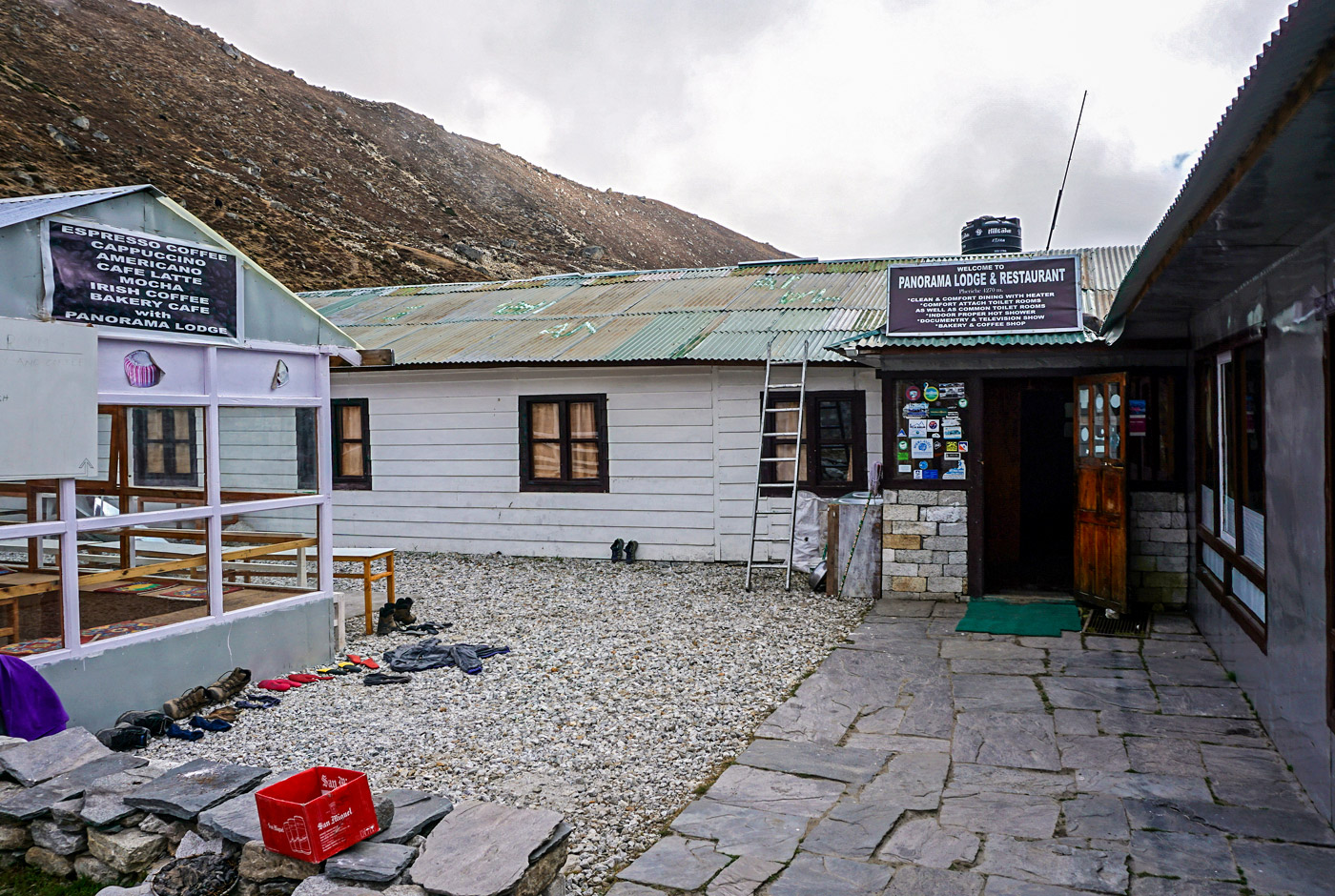
Teahouses are simple, family-run lodges with:
- Twin rooms with basic beds and blankets
- Shared bathrooms (Western-style in lower villages, squat toilets higher up)
- Communal dining halls with a stove for warmth
Heating is limited, so bring a good sleeping bag. Hot showers are available for a fee, but may be unavailable at higher altitudes.
The heart of every teahouse is the dining hall, where trekkers gather around the stove to share meals, play cards, and trade stories. This sense of community is one of the highlights for first-time trekkers.
Comfort vs. Reality
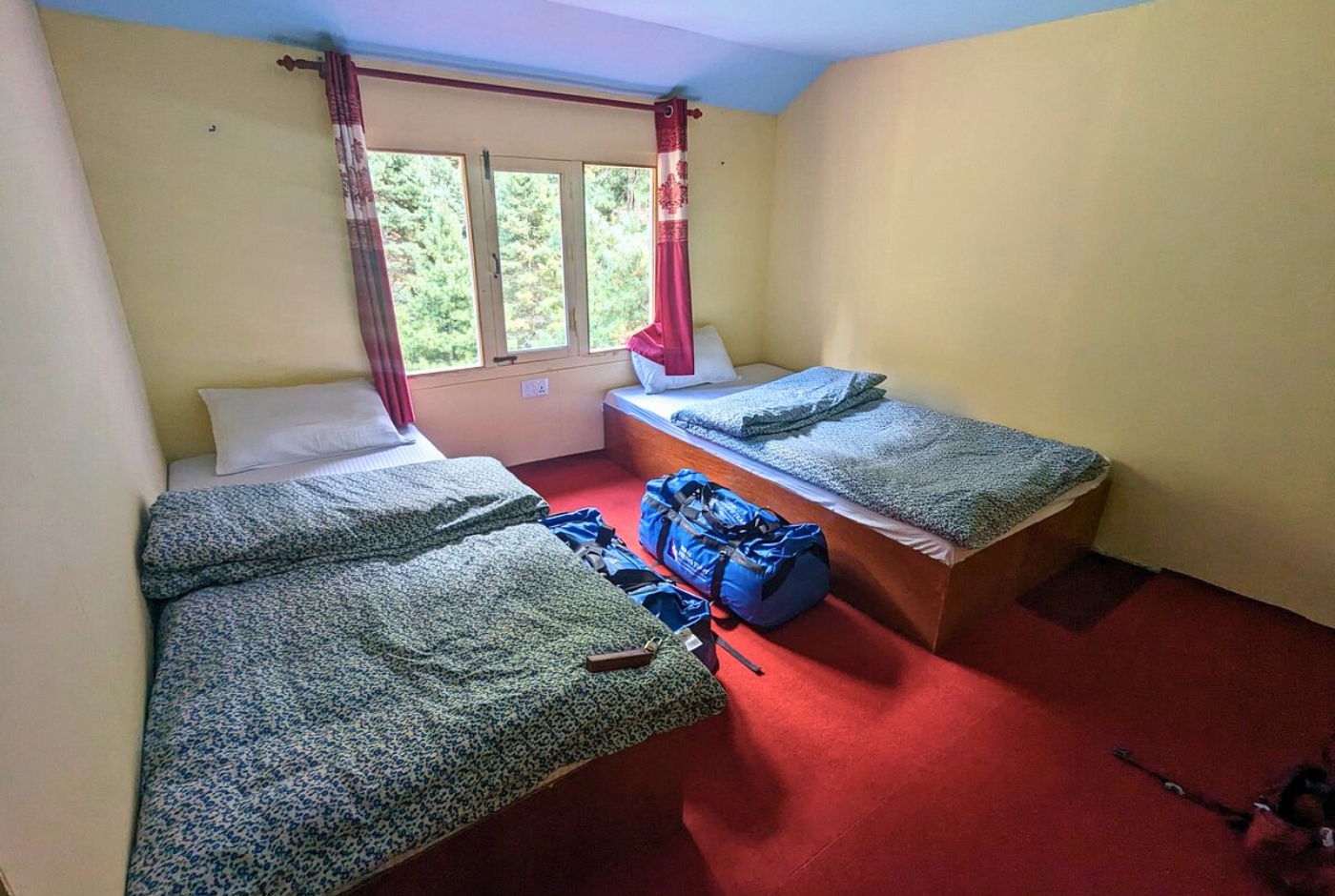
For beginners, the teahouse facilities might feel simple compared to hotels. Rooms are unheated, showers are limited, and Wi-Fi can be slow. But this simplicity is part of the charm. After a long day of trekking, a hot cup of tea, a warm meal, and a cozy bed are all you truly need.
Communication and Connectivity
In today’s world, staying connected matters even on the trail. Many novice trekkers wonder if they’ll be completely cut off. You’ll have options, but service is limited.
- Wi-Fi: Available in most teahouses, but costs $5–$10 and gets slower the higher you go. Some trekkers buy an AirLink card for better coverage.
- Mobile Networks: Buy an Ncell or NTC SIM in Kathmandu. Service is available in Lukla and Namche, but becomes less reliable at higher altitudes.
- Charging: Available in villages, but costs an additional fee ($2–$5 per hour). Carry a power bank or solar charger for backup.
For many beginners, this turns into a hidden blessing. Without constant social media, you focus on the trail, the people around you, and the mountains.
Practical Tips for Beginners to Complete Everest Trip
Here are 10 insider tips that make a big difference for first-time trekkers:
- Pace yourself: Altitude rewards patience, not speed.
- Respect the altitude: Never ignore a headache or nausea.
- Pack light but smart: Pack Essentials only. Rent extras in Kathmandu.
- Stick to vegetarian meals: Safer and easier to digest.
- Hydrate constantly: 3–4 liters per day, purified.
- Expect basic facilities: Shared bathrooms, limited hot showers.
- Carry cash in rupees: ATMs are unreliable beyond Namche.
- Train with a daypack: Prepares your shoulders and back.
- Respect Sherpa culture: Small gestures mean a lot.
- Enjoy the journey: Don’t focus only on Base Camp.
Here are detailed tips to prepare for and complete the Everest Base Camp trek, covering physical training, essential gear, altitude management, and logistical planning.
5 main challenges for beginners on the Everest Base Camp
- Altitude Sickness (AMS): The high altitude above 2,800 meters (where the trek begins) and reaching up to 5,364 meters at Everest Base Camp height puts a tremendous strain on the body. Beginners are particularly vulnerable to symptoms like headaches, nausea, dizziness, and shortness of breath, which can become serious if proper acclimatization is not followed.
- Challenging Terrain: The trail isn't a simple path; it involves long days of trekking on steep, rocky, and uneven paths, as well as suspension bridges and rugged mountain trails. Beginners will need good balance and stability, and physical conditioning to handle the constant ascents and descents.
- Trek Length and Physical Demands: The trek is a long journey, typically 12-14 days, requiring 5-8 hours of walking each day on consecutive days. This sustained daily activity leads to fatigue and physical exhaustion, which is challenging for those not accustomed to such endurance tests.
- Harsh and Unpredictable Weather: Conditions in the Himalayas are known to be severe, with cold temperatures, strong winds, and unpredictable snowfall that can change rapidly, even in favorable seasons. For beginners, these harsh conditions can add to the difficulty and impact the trek.
- Limited Amenities and Basic Facilities: Accommodation is in simple "teahouses" with basic facilities, and there are few modern conveniences available. Beginners, accustomed to more developed accommodations, may find the limited hygiene, basic food options, and lack of amenities a significant challenge.
Problems Novice Trekkers Face During the Everest Base Camp Trek
The Verdict: Can Beginners Really Do the Everest Base Camp Trek?
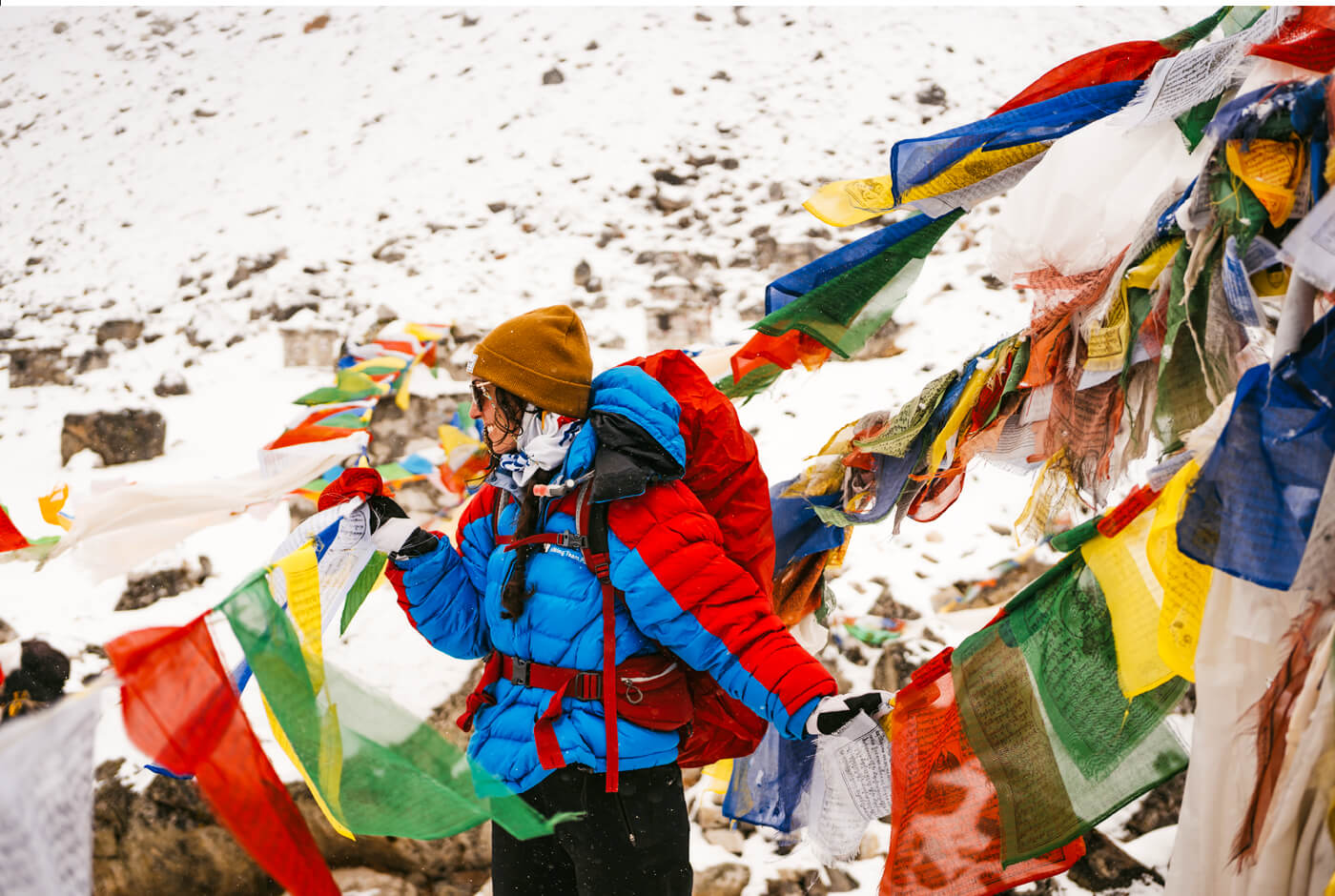
Yes, novice trekkers, families, and even first-time trekkers with no experience can absolutely reach Everest Base Camp. Thousands of people from all walks of life complete the trek every year.
It’s not about being the fittest or the strongest. It’s about:
- Preparation before you leave home
- Following a beginner-friendly itinerary
- Listening to your body and respecting the altitude
- Trusting your guide and pacing yourself
The Everest Base Camp trek isn’t just about adventure. It’s about testing your patience, resilience, and sense of discovery. During this trek, you’ll hike through forests, cross suspension bridges, hear the laughter of Sherpa villages, and finally stand in awe of the world’s tallest mountains.
The final step onto Base Camp at 5,364 meters isn’t just about the view; it’s about realizing that as a beginner, you made it through every challenge.
Everest base camp trek for beginners itinerary - 14/16 days trip package
- Day 01: Arrive in Kathmandu (1,400m / 4,593ft) and transfer to your hotel to start the journey
- Day 02: Spend a full day in Kathmandu (1,400m / 4,593ft) for trek briefing, gear check, and final preparations
- Day 03: Fly to Lukla via Kathmandu/Ramechhap (2,860m / 9,383ft) and trek through Chheplung and Ghat to reach Phakding (2,652m / 8,699ft) – 8km, 3 hours
- Day 04: Trek from Phakding to Namche Bazaar (3,440m / 11,283ft) via Monjo and Jorsalle – 10–12km, approx. 6 hours (Steep ascent to Namche – hard day)
- Day 05: Acclimatization hike from Namche to Everest View Hotel (3,962m / 12,995ft), passing Syangboche and returning – 3–4km, 3–4 hours
- Day 06: Walk from Namche to Tengboche (3,860m / 12,660ft) via Kyangjuma and Phunki Tenga – 10–11km, 5 hours
- Day 07: Trek from Tengboche to Dingboche (4,410m / 14,464ft), passing Pangboche and Somare – 11–12km, 5 hours
- Day 08: Hike to Nagarjun Hill (5,100m / 16,732ft) above Dingboche for acclimatization and return – 5–6km, 4–5 hours
- Day 09: Trek to Lobuche (4,910m / 16,105ft) via Dughla and Thukla Pass memorials – 11–12km, about 5 hours
- Day 10: Reach Everest Base Camp (5,364m / 17,594ft) via Gorakshep (5,180m / 16,990ft) and return to Gorakshep – 14–15km, 8 hours (Toughest day of the trek)
- Day 11: Hike up Kala Patthar (5,545m / 18,190ft) for sunrise views, then descend to Pheriche (4,210m / 13,810ft) via Lobuche – 13–14km, 7 hours (Long descent – hard day)
- Day 12: Trek to Namche Bazaar (3,440m / 11,283ft), passing Pangboche and Tengboche again – 14–15km, around 7 hours (Another long descent – hard day)
- Day 13: Return to Lukla (2,800m / 9,184ft) via Monjo and Phakding on the final trekking day – 18–19km, 7 hours (Longest descent of the trek)
- Day 14: Return to Kathmandu from Lukla either directly or via Ramechhap and enjoy a relaxing afternoon in the city
- Day 15: Use a buffer day in Kathmandu (1,400m / 4,593ft) for flight delays or optional sightseeing
- Day 16: Transfer to Tribhuvan International Airport for your departure from Nepal
Frequently Asked Questions (FAQs)
Can a beginner do Everest Base Camp Trek without a Guide and porter?
No, a beginner generally cannot do the Everest Base Camp (EBC) trek without a guide and porter, as new regulations in 2023 require all trekkers on restricted routes, including EBC, to hire a licensed guide for safety, permit assistance, and emergency support. While the trail itself is well-trodden, the risks of altitude sickness, getting lost, and coordinating rescues are high for inexperienced individuals, making a guide essential for a beginner's safety and success.
Is it possible to trek EBC without previous trekking experience?
Yes, it’s very possible. The Everest Base Camp trek is designed for ordinary people, not just seasoned mountaineers. Many novice trekkers and families with no experience complete the journey each year.
What matters most is pacing yourself, following a beginner-friendly itinerary, and respecting the altitude. With the right mindset and guidance, even first-time trekkers can successfully reach Base Camp.
Can a beginner do the Everest Base Camp?
Absolutely. A beginner can trek to Everest Base Camp if they prepare with some light training and choose an itinerary that allows enough acclimatization days. The trail has a steady rhythm, and thousands of first-time trekkers complete it every season.
Families, solo travelers, and groups of friends all walk the same path. What makes the difference is patience, preparation, and the support of an experienced guide.
Can you hike EBC without a guide?
No. As of 2023, trekking without guide support is not permitted on most major routes in Nepal, including the Everest Base Camp route. While the trail is well-marked, safety is a serious concern, especially for novice trekkers and first-time trekkers without guide experience.
A licensed guide not only keeps you safe but also handles permits, logistics, and helps if altitude sickness becomes a problem. For beginners and families, having a guide is one of the best decisions you can make.
Can anyone do the EBC trek?
Yes, almost anyone with determination can take on the EBC trek. Age is not a barrier; you’ll find trekkers as young as five and as old as their late 70s enjoying the journey.
Fitness levels vary, but with the right pace and enough rest, the trek is achievable for both beginners and families with no experience. It’s less about being super fit and more about walking slowly, listening to your body, and enjoying the adventure.
What is the 2pm rule in Everest?
The "2pm rule" on Mount Everest is a critical safety guideline that requires climbers to turn around by 2:00 PM if they haven't reached the summit, even if they are still close to the top. This rule is necessary to avoid being caught on the mountain after dark and during treacherous afternoon weather, which can bring strong winds and low visibility, increasing the risk of descending in darkness and facing dangerous conditions.
Is Everest Base Camp trek suitable for beginners?
Yes, the Everest Base Camp (EBC) trek is suitable for beginners if they are well-prepared physically and mentally. While not a technical climb, the trek is challenging due to the altitude (up to 5,364 meters) and requires good fitness, consistent preparation, and proper acclimatization to avoid altitude sickness.
Can you do Everest Base Camp without training?
No, you cannot safely do the Everest Base Camp (EBC) trek without any physical training; while it's a non-technical trek, it requires significant endurance for prolonged high-altitude walking, and attempting it without preparation is dangerous and strongly not recommended. Proper training, a good level of physical fitness, mental preparation, and effective acclimatization are crucial for a successful and safe trek.
It’s not ideal for beginners. The trek doesn’t need advanced climbing skills, but doing some basic training helps. Novice trekkers who practice regular walks, short hikes, or light cardio before the trip usually find the journey much more manageable.
Without preparation, novice trekkers may struggle with long days on the trail. A little effort before you go makes the journey safer and far more enjoyable.
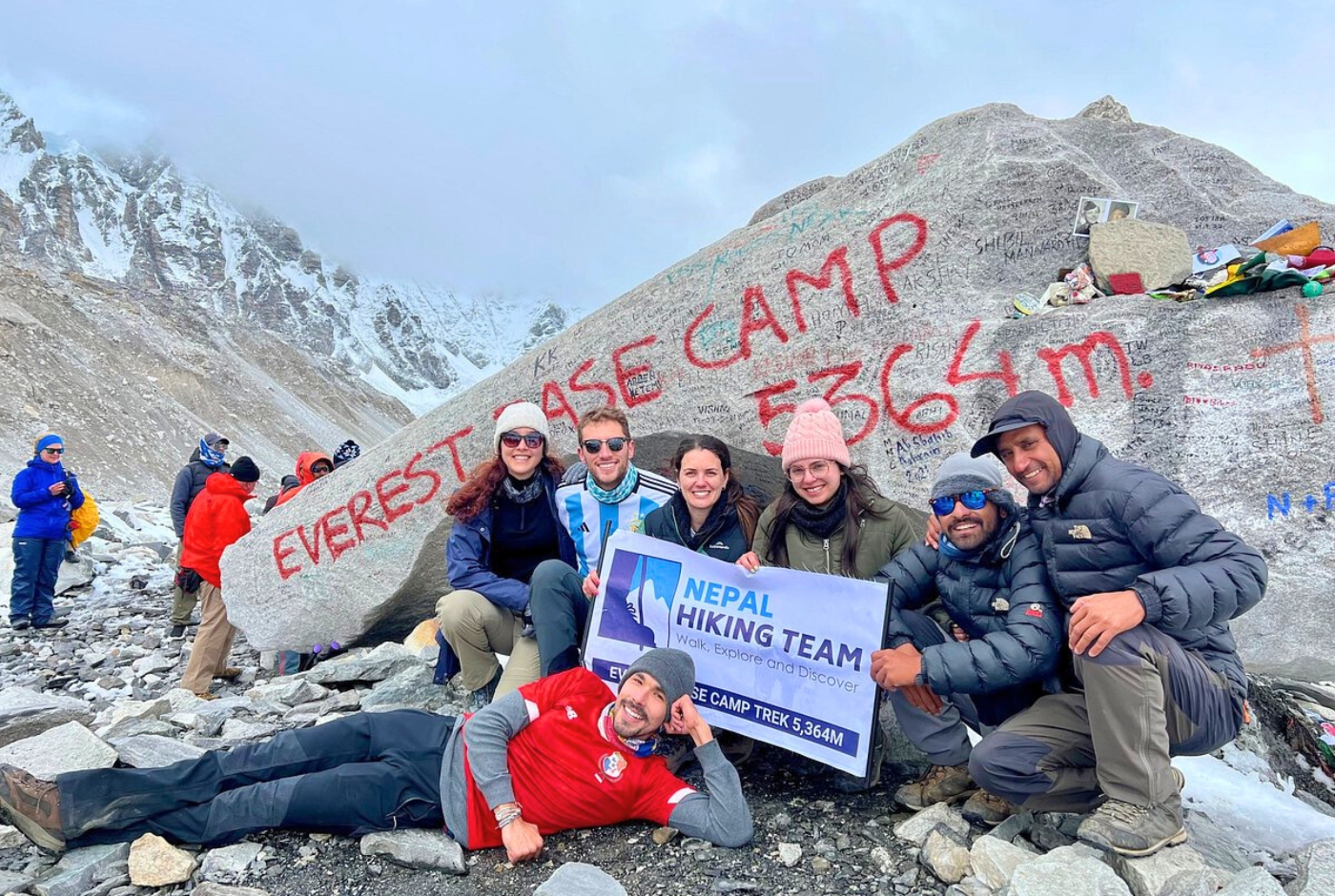
Conclusion
If you’re a beginner, selecting the right company can make all the difference. At Nepal Hiking Team, we have years of experience guiding novice trekkers, families, and first-time trekkers without guide experience. Our Everest Base Camp trek packages include beginner-friendly itineraries, professional guides, porter support, and all logistics, from permits to flights, are handled.
What sets us apart is care. We’ve successfully guided people of all ages from children as young as five to trekkers in their late seventies, and our clients often describe their journey as unforgettable.
When you trek with us, you’re not just signing up for a journey; you’re joining a family that looks after you every step of the way. For beginners planning their Everest Base Camp adventure, we are the best choice to make your dream come true.


